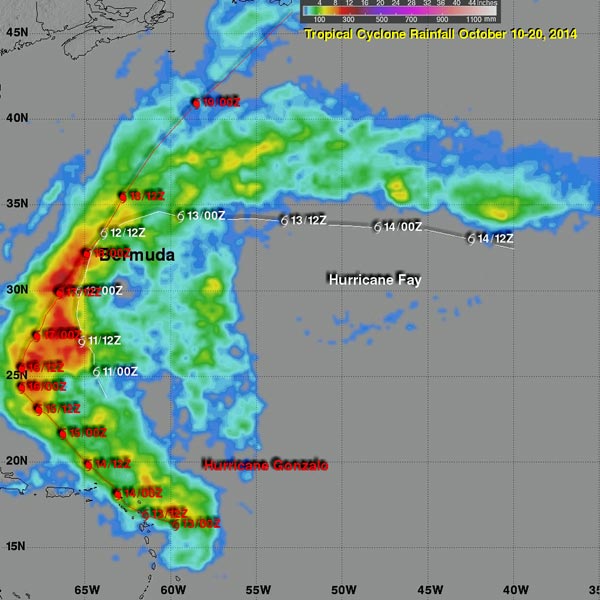NASA's TRMM Satellite Calculates Hurricanes Fay and Gonzalo Rainfall

This rainfall analysis showed that Gonzalo generated several areas over the Atlantic Ocean where rainfall totals topped 12 inches (red). Fay's maximum rainfall appeared between 4 and 8 inches (green). Image Credit: NASA/SSAI, Hal Pierce
Tropical Storm Fay battered Bermuda on October 12, 2014 and became a hurricane after passing the island. The following Friday powerful Hurricane Gonzalo passed directly over the island on Friday October 17, 2014 causing flooding and damage to many structures.
The remnants of Gonzalo also pounded the British Islands with winds exceeding 70 mph causing the death of at least one person.
An analysis of rainfall was conducted on Fay and Gonzalo as they moved through the central Atlantic Ocean and over Bermuda. The analysis was based on near real time TRMM-based precipitation estimates (TMPA) that were produced by merging data from several satellites.
The analysis showed that Gonzalo generated several areas over the Atlantic Ocean where rainfall totals topped 12 inches (300 mm). Fay's maximum rainfall was between 4 and 8 inches (100-200 mm).
The rainfall estimates have been developed at the NASA Goddard Space Flight Center in Greenbelt, Maryland by the precipitation research team. The type of data used in this analysis is expected to be superseded by a Global Precipitation Measurement (GPM) mission product in late 2014.
TRMM is managed by NASA and the Japan Aerospace Exploration Agency. For more information about TRMM, visit: trmm.gsfc.nasa.gov. For more information about GPM, visit: www.nasa.gov/gpm.
Hal Pierce
SSAI/NASA's Goddard Space Flight Center
Media Contact
All latest news from the category: Earth Sciences
Earth Sciences (also referred to as Geosciences), which deals with basic issues surrounding our planet, plays a vital role in the area of energy and raw materials supply.
Earth Sciences comprises subjects such as geology, geography, geological informatics, paleontology, mineralogy, petrography, crystallography, geophysics, geodesy, glaciology, cartography, photogrammetry, meteorology and seismology, early-warning systems, earthquake research and polar research.
Newest articles

Trotting robots reveal emergence of animal gait transitions
A four-legged robot trained with machine learning by EPFL researchers has learned to avoid falls by spontaneously switching between walking, trotting, and pronking – a milestone for roboticists as well…

Innovation promises to prevent power pole-top fires
Engineers in Australia have found a new way to make power-pole insulators resistant to fire and electrical sparking, promising to prevent dangerous pole-top fires and reduce blackouts. Pole-top fires pose…

Possible alternative to antibiotics produced by bacteria
Antibacterial substance from staphylococci discovered with new mechanism of action against natural competitors. Many bacteria produce substances to gain an advantage over competitors in their highly competitive natural environment. Researchers…





















